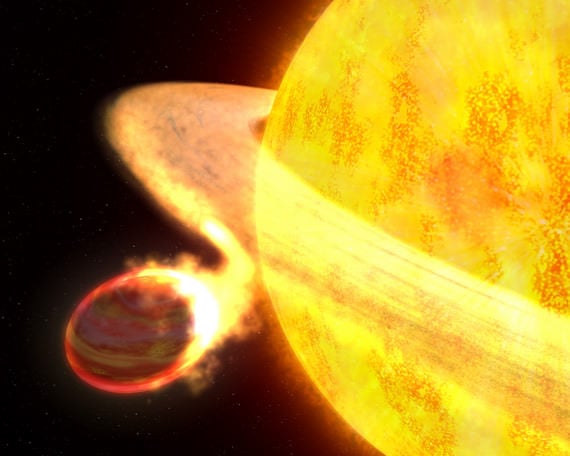Satellite Images Show Oil Slick on the Move Towards Florida, Possibly East Coast of US

Hubble Confirms Star is Devouring Hot Exoplanet

Carnival of Space #154

Amazing Time-Lapse Video of Space Shuttle Discovery
Citizen Science Goes to the Moon

Where In The Universe Challenge #105

More Up-Close Images of Eyjafjallajokull Volcano and Its Effect on Life in Iceland

What is the Air Force's Secret X-37B Space Plane Doing in Orbit?

Hail to His Spiralness, M83

A New Kind of Supernova Explodes in Unusual Way

Incredible Images of Enceladus From Cassini's Latest Flyby

Japan to Launch Venus Orbiter and Solar Sail Missions

Space Station Gets a New Science Module

Gorgeous Venus-Moon Conjunction Images

Cassini's Cruise: Close Flybys of Two Moons in Less Than Two Days

Is Ball Lightning Just a Shared Hallucination?

Last Chance for Phoenix to Call Home Starts Today

Rare Images of Shuttle Booster Return

Answer to Universe Puzzle No. 13 Now Posted

Astronomy Without A Telescope - Making Sense Of The Neutron Zoo

Atlantis Launch Gallery

New Views of Meridiani Planum Show Deposits of Volcanic Ash

Atlantis Launches Successfully on Last Scheduled Flight (Video)
Weekend SkyWatcher Forecast: May 14-16, 2010

So, How Would YOU Dress for Atlantis' Last Scheduled Launch?

The Grand Triumphs and Close Calls of Space Shuttle Atlantis

Jupiter, It Is A-Changing

Volcano Cam Now Available

WISE Pictures the Tadpole Nebula with a String of Pearls

NASA Technology Helping in Oil Spill Response
Astronomy Cast Ep. 183 & 184: History of Astronomy Parts 1 & 2
Latest Satellite Images of Eyjafjallajokull, the Volcano that Keeps on Giving

Where In The Universe Challenge #104

Carnival of Space #153

One Moment, Two Worlds

X-Ray Observations Find Evidence for "Missing Matter" in the Universe

Runaway Star Needs Its Own Reality Docu-Drama

Black Hole Gets Kicked Out of Galaxy

Young Stars Blast a Hole in Space

Universe Puzzle No. 13

Newton's Apple Tree to Defy Gravity on Upcoming Shuttle Mission

Team Finds Most-Distant Galaxy Cluster Ever Seen

Latest Mars Avalanche Likely Triggered by Impact Event

Incredible! Cassini as Houdini Cuts Titan in Half

This Week In Space With Miles O'Brien
Astronomy Without A Telescope - Bringing The Planetology Home

Final Round of Apollo 13 Questions Answered by Jerry Woodfill

First Full Science Results in From Herschel

 Universe Today
Universe Today